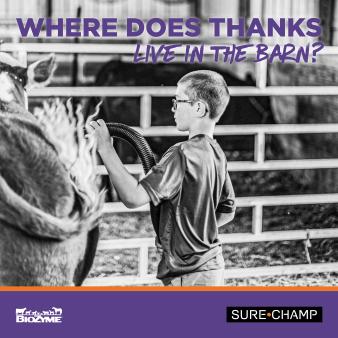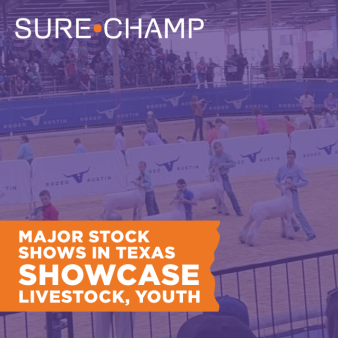
Midwest state fairs often signify the end of a show season for many young cattle exhibitors, but with every ending comes a new beginning. Soon, cattle operations will be offering this year’s calf crop through their fall sales to potential buyers who are already making plans for their next show season. It’s enjoyable to walk through runs of nicely groomed, gentle calves. But this process doesn’t happen overnight.
Blaine Rodgers, owner of Rodgers Livestock, Savannah, Missouri, shares his sales preparation tips and advice with those looking to host a sale this fall.
Calf health is the first area that Rodgers said needs to be addressed, and that starts with a booster round of vaccinations. Regardless if a calf is raised and weaned on Rodgers’ place or a calf he has brought in from another breeder, he said it is vital to make sure the calves start out healthy.
“Their immune system becomes compromised by all the stress they are put through, so we need to make sure they start out healthy. On the cattle I get in on consignment, I can tell you who does a good job and who doesn’t just by how they react (to the stress). You’ve got to make sure you’ve got a good handle on their health before you get started,” he said.
Rodgers keeps records of all the vaccinations and dewormer the cattle are given along with the dates they are administered for further reference. He also records any time he has to treat a calf, because as he said even the best manager will have some illness throughout the fall, especially with fluctuations in temperatures being so extreme.
“Our biggest challenge right now is monitoring them daily on temperature and environmental changes. The fluctuation in temperatures are hard on them. On extremely hot days, we try to bring them all in and put them under fans so they can stay cool, but we prefer to let them stay out in the lots with round bales and let them be cattle as much as we can,” he said.
Rodgers suggests monitoring health early each morning before the heat of the day sets in. If you do have one that gets sick, separate it and get it treated. Make sure it is feeling 100% again before you put it back with the group to ensure that it won’t relapse due to the stress of daily care or extra movement through the pens.
When commingling calves from various origins, it is important to look for signs of coccidiosis. The young calves are susceptible to coccidiosis, and it can cause them to go backward, or lose performance in a hurry. Rodgers suggests adding an ionophore to the feed. If a person is unsure of their calf’s diagnosis, they should collect and test a stool sample to ensure proper treatment.
One of the most important ways to keep your calves healthy and get that bloomy appearance on them is through a good nutrition program. Always be sure to provide your calves with plenty fresh, clean, cool water. Even when in the barns under fans, Rodgers said it is imperative to offer the calves a water source. And always be sure to keep plenty of hay in front of them to keep their rumens functioning, since a healthy digestive system typically lends itself to a healthy animal.
“Keep free-choice hay in front of them all the time to keep their rumen working. We’re always putting extra grain in them to grow them but need to keep their digestive tract on focus. Even when we put them in the barn, there are feeders with hay for them,” he said.
Another way that Rodgers keeps his cattle healthy and their digestive system in check is by feeding them Amaferm®. Amaferm is a precision prebiotic designed to enhance digestibility by amplifying the nutrient supply for maximum performance. It is research-proven to increase intake, digestion and absorption. Rodgers uses the Sure Champ® Pack or other methods to make sure his calves benefit from the Amaferm advantage.
He also includes the Vita Charge® Stress Tubs in all his runs. The Vita Charge Stress Tubs include Amaferm and MOS and help promote feed and water intake during times of stress and recovery.
Once he’s ensured his cattle are healthy, eating and on a good plane of nutrition, the other priority for Rodgers is to make his calves look like show prospects, including having them halter broke and hair worked.
“The one thing we flirt with being the hardest decision on them is we’re trying to get them sale ready and we’re trying to get them bloomy, yet at the same time we’ve got to get them broke and we want to get them hairy. There’s a fine line – the harder you work on them, the faster they shed weight. If we don’t mess with them, it’s the best way to get them ready condition wise, but we have to worry about getting them gentle enough and get their hair coming in too,” he said.
The calves are put through a tough week right from the start to get them broke from the onset. First, Rodgers will pen wash a group by putting about four loose calves in a smaller pen. The dirt is blown out, they are washed and blown dry.
“It’s amazing! Pen wash them once or twice, and you’re scrubbing on them, and it feels good and they cool off. They learn you’re not a bad person. It’s probably the quickest way for us to make headway,” he said.
Once the calves have gentled down and are used to people, they will halter them, and put them in alley way head-to-tail to get used to standing with the halters on. Someone is always around to make sure they don’t flop around and get hurt and to rub on the calves. Doing this for three to four days before they are tied is a good way to introduce them to the halters without getting the calves or people hurt.
Rodgers said if they have any calves that do need dehorned, they will halter break them first, and then dehorn them. This allows them to rest for a couple of weeks to heal without having their heads messed with.
Once the calves are accustomed to their halters and being tied, it’s time to focus on their hair and skin. Rodgers suggests rinsing, conditioning and blowing them dry several times a week. Avoid using shampoo more than once or twice weekly, as shampoo dries their hair and skin. He tries to rinse and dry them quickly so he can get them untied and turned back out into their runs, because the longer they stand, the more weight they will lose.
Finally, if you are going to spray them with anything, make sure to avoid heavy oils. Use a real light sheen in the fall, as heavy oils will add to the heat, causing them stress and potentially lowering their gains.
Herd health. Nutrition. Halter breaking. Skin and hair care. These are the foundations of preparing sale calves for the buyer to find his or her next project. Not everyone does it the same, but these basic principles apply to help develop a low-stress, eye-appealing, high-quality sale offering.

